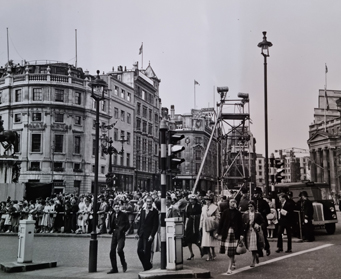Continuing a feature on how Metropolitan Police experiments with closed circuit television in London go back to the dawn of its use, as a single file at the National Archives at Kew in west London shows.
On November 1, 1960, EMI tested their cameras at Canada House and the National Gallery; the monitor in Trafalgar Square and the ‘slave’ monitor tied to the Trafalgar Square one, at Met headquarters. EMI’s technicians could not get the camera in Canada House to work, even after two hours; while the one at the National only gave ‘dim outlines’. EMI still wanted to carry out the November 5 test, as the cameras were in position, and the Ministry of Works had fitted a 10kW light on the National Gallery; although police had assumed the Ministry would provide at least two.
Afterwards police recorded, ‘as was anticipated, the television did not assist the senior officers in controlling this particular [Saturday] occasion. Despite strong representations to the Ministry of Works the floodlighting was still inadequate and in some cases wrongly positioned. This had the effect of reducing the quality of picture which might otherwise have been obtained and I understand that during the afternoon when the cameras were first installed very good quality pictures were obtained in daylight.’
As for a monitor in the viewing box, ‘from that position one could see more with the naked eye than could be shown on the screen’. But another monitor, at Great Scotland Yard, ‘demonstrated the possibilities of remote viewing’. EMI meanwhile were pleased by the experiment, ‘on a scale beyond anything yet’. With such novel kit, police did not know how information from the monitors could be applied by officers at the scene. They did not feel justified in buying any of the equipment; yet. The deputy commissioner likewise pronounced he ‘was not impressed by what I saw … in the day time for crowds and traffic it will be more useful’. He, too, though, wanted to experiment further, even though the Met would have to pay EMI.
There the story stood for a few years. As late as November 1964 police stated they were against using CCTV only as a ‘gimmick’, while noting that the new M4 viaduct at Hounslow in west London was having CCTV. Similarly a typed note of March 1965 in the file said CCTV was more satisfactory for traffic purposes, and not yet ‘of great assistance in the detection of crime …. for crowd control especially at large meetings television could enable the movement of agitators to be picked out and followed but again its use is restricted to daylight hours’.
A Met assistant commissioner visited a CCTV traffic installation in Munich city centre in 1963; and by March 1965 CCTV was in use at Hammersmith bridge. Birmingham University was carrying out traffic studies with CCTV from inside Grays Inn Road police station, to watch the junction with Theobalds Road and Clerkenwell Road. Police in Liverpool city centre were trying two pairs of cameras, from Pye and EMI, from a different building about every two weeks. Liverpool, too, found street lights were not enough after dark. Liverpool tried ‘a special infra-red tube in the camera’ and floodlights with black filters.
In April 1965 the Met suggested a trial of a camera with a zoom lens where receivers of stolen property ‘conduct their business on the pavement and in the adjoining cafes usually buying direct from known house-breakers’. Police knew about the crime, then; they wanted evidence against the criminals. Police proposed cameras on buildings, and communication between an officer watching on a monitor, and in the street, by ‘walkie-talkie apparatus’. Such use would be ‘intermittent’ and police proposed only hiring two cameras and two monitors. The Met got Home Office permission verbally in advance, ‘and covering written authority obtained later’. That was as close as these experiments came to any oversight.
While the ‘apparatus’ was in place by July 1965, ‘unfortunately the cameras are much more conspicuous than had been anticipated’, in Hatton Garden, then as now a centre for the diamond trade. The experiment of one month went ahead. “One of the interesting sidelines,” police reported afterwards, “is the effect on legitimate business traders in the area who were delighted with the extra protection afforded them particularly in view of the number of robberies which have taken place in the area.” Police were discovering from the start of their use of CCTV that beside the tangible – arresting thieves and recovering property – they stood to gain intangibly, from law-abiding locals feeling safer, even if ignorant of what the CCTV could actually achieve.
Police made three arrests, and described the experiment – important enough for the commissioner to be told – as worthwhile; and proposed repeating it in the autumn. “There is undoubtedly a lot of snags with the present equipment and if closed-circuit television is to play a part in combating crime the equipment will have to be vastly improved.”
The Hatton Garden experiment had cost £150 for the hiring – a tenth of the list price; and £100 for the fitting and taking away; in an era when a working-class man might earn £10 a week. Police concluded they would have to buy their own rather than rent; and use their own technicians to install. CCTV was still meant to be covert; an October 1965 memo stated ‘in particular the equipment must be installed unobtrusively and the cameras must be sited inconspicuously’.
Pictured: from that file at Kew, Mepo 2/9956, one of the photos taken by electronics firm EMI of the trial use of CCTV in July 1960, to track the route of a horse-drawn carriage taking the Thai king and queen on a state visit from Buckingham Palace to Guildhall – then as now involving a considerable and complicated crowd control and security operation for police.
Continued: see part three, via link.









